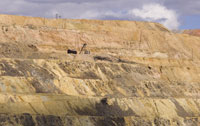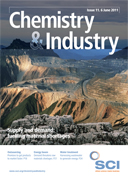At the start, it was all about rare earths. Comprising the 15 lanthanide elements, stretching from lanthanum to lutetium, as well as the related metals scandium and yttrium, the rare earths have a variety of unique but highly useful optical, electronic and magnetic properties.
As a result, they are essential to the proper functioning of a whole range of ubiquitous modern technologies, including display screens, mobile phones, hard disk drives and wind turbines. So it’s no surprise that a potential shortage of these elements would cause a great deal of concern.
But rare earths could well just be the start; there are a whole host of other elements with useful properties that our modern technologies rely on, especially our modern energy technologies, which could be hit by shortages in the future, for example, the platinum and palladium that are a central component of many catalysts, the lithium and cobalt found in rechargeable batteries and the indium and tellurium used in photovoltaic cells. Together with some of the rare earths utilised in energy technologies, such as neodymium and samarium, these elements have been termed ‘energy-critical’ elements.
Athough ways of dealing with these forthcoming shortages are being explored, a long-term solution could require a sea-change in our attitudes to these elements. ‘We need to think about material in unprecedented ways,’ warns Cyrus Wadia, a scientist at the Lawrence Berkeley National Laboratory and co-director at the University of California Berkeley’s Clean Tech to Market Program, who is currently serving as a senior policy adviser to the White House Office of Science and Technology Policy.
So what is causing the shortages? Well, the main problem is the age-old story of supply and demand. On the demand side, the continuing growth in the global demand for these technologies is causing an associated growth in the demand for rare earths and other energy-critical elements. Take cadmium and tellurium, which are the central elements in a novel type of photovoltaic cell: over the past couple of years, sales of cadmium-tellurium photovoltaic cells have more than doubled every year, and so demand for cadmium and tellurium has also more than doubled.

It therefore only makes financial sense to mine rare earths from the richest deposits. Many of the other energy-critical elements are not mined directly at all, but are instead extracted as co-products or byproducts from mining operations for other, more abundant and lucrative elements. So, indium is a byproduct of zinc, copper and tin mining, and selenium and tellurium are byproducts of copper mining. Several rare earths can also be produced as byproducts of mining for iron, tin, thorium and uranium.
What this means is that the economics of mining rare earths and other energy-critical materials are not particularly healthy, and so in many countries there has been no great incentive to produce them. Even when produced as a byproduct, rare earths and energy-critical elements are viewed as far less important than the main product. Admittedly, this is hardly surprising when you consider that the annual market for copper was worth around $80bn in 2009 whereas the annual market for tellurium, which is a byproduct of copper mining, was worth just $30m. China has been the great exception to this general lack of interest in rare earths and now dominates production. It may possess the world’s richest deposits of rare earths, with just over half of the known reserves, but that still doesn’t explain why China currently accounts for over 95% of all rare earth production.
China is in this enviable position because it made a concerted effort in the mid-1980s to build up its rare earth mining activities. By the 1990s, Chinese companies were producing rare earths so cheaply that producers in other areas of the world were unable to compete and so most simply stopped mining. This is what happened at Mountain Pass in southern California, which used to be the largest US rare earth mine but was mothballed by its owner Molycorp in 2002, although environmental problems also played a part in the mine’s closure.
As a result, China became the dominant producer just as demand for rare earths began to pick up. China has increased production in response, with the global production of rare earths growing from around 60,000t in 2000 to 127,000t in 2010, but is also passing less and less of this production on to the rest of the world. It introduced export quotas for rare earths in 2005 and has lowered them steadily ever since: China’s exports of rare earth ores fell from 65,609t in 2005 to just 30,258t in 2010.
Analysts think China is doing this to encourage the growth of its own high-tech industries. As a result, in a few years China could well soak up its entire production of rare earths, leaving none for the rest of the world. It may also be using rare earths as political bargaining chips. In 2010, China was accused of deliberately withholding shipments of rare earths to Japan, the world’s biggest importer, in retaliation for an ongoing territorial dispute. China’s tactics over rare earths are raising concerns about the supply of other energy-critical elements, the production of which is also often concentrated in just a few countries. For example, around 80% of the world’s platinum is produced in South Africa, while lithium is mainly produced in just three South American countries: Chile, Bolivia and Argentina. This means that the supply of these elements could easily be disrupted, either deliberately or as the result of some unforeseen disturbance. But if economic and political factors are causing the problem, they could also provide a solution. For the immediate effect of the shortages in rare earths and other energy-critical elements has been to raise their prices; collectively, the price of rare earth elements has increasing by a factor of 10 since 2005, with the price of cerium increasing by a factor of 20. As a consequence, rare earths and certain energycritical elements are becoming a more attractive mining proposition.
Molycorp is currently dusting off its Mountain Pass mine and intends to resume rare earth production by the end of 2012. Initially, Molycorp said that it would produce 20,000t of rare earth oxide each year at the mine, but in January 2011 it announced plans to double the mine’s production capacity to 40,000t by the end of 2013.

Still, it will be some time before any of these developments have a major impact on the production of rare earths or other energy-critical elements. ‘It’s difficult for the mining industry to respond very rapidly to a change in demand for any commodity,’ says Lusty. ‘To bring a new metal mine into production typically takes more than 10 years.’
According to a report on rare earths published by the US Department of Energy in December 2010, the new and expanded mines coming onstream over the next few years could increase rare earth production by around 60,000t a year. But this will not be enough to break US dependence on Chinese production, which could continue for a further 15 years. The recent high prices are also helping to make the recycling of rare earths and other energy-critical elements more economically feasible. At the moment, there is hardly any recycling of rare earths, despite the fact that certain electronic devices contain higher concentrations of rare earths than are present in natural deposits. There is more recycling of certain other energy-critical materials, particularly precious metals such as platinum and palladium.
One of the pioneers of this type of recycling is the Belgian materials technology company Umicore, which operates a plant in Hoboken, Belgium, that recycles 17 different metals, including energy-critical elements such as platinum, palladium, indium, selenium and tellurium. The plant recycles these metals from old electronic devices, catalysts and residues from metal refiners.
Umicrore’s recycling process takes advantage of the fact that these 17 elements will preferentially bind to certain common metals, such as copper and lead. ‘Molten copper is used to trap some of these elements, typically the precious metals, while a lead oxide slag traps the other elements,’ explains Geoffroy Raskin, head of investor relations at Umicore. The elements are then separated from each other and further processed using techniques , such as electrolysis, to produce pure streams of each element.
Around half of Umicore’s material requirements can now be met by these recycled elements, while the remainder are sold on the open market. The firm has also recently developed another process for recycling lithium, nickel and cobalt found in batteries. This uses temperatures over 3000°C to transform the batteries into an ionised gas plasma, from which lithium, nickel and cobalt can be efficiently extracted. Umicore is now looking to apply its recycling technology to other materials, including potentially rare earths. But recycling can only help to use existing supplies of rare earths and energy-critical elements more efficiently, it can’t greatly expand those supplies and so can’t hope to meet the kind of major increases in demand seen over the past few years. And if that demand continues to increase, especially if driven by the widespread adoption of new energy technologies, we are fairly quickly going to start going beyond economic and political constraints and hitting practical constraints, which are a great deal more intractable.
Take tellurium again: 400t of tellurium are currently required to produce enough cadmiumtellurium photovoltaic cells to generate 1GW of electrical power, about the same as a single large conventional power plant. In 2009, however, the global production of tellurium was just 200t. ‘If we’re serious as a global community about meeting the world’s energy needs from renewable sources then we’re going to be using materials at unprecedented scales,’ says Wadia.
Rather than simply employing elements that naturally posses the properties required in our modern technologies, even if they’re in short supply and difficult to obtain, Wadia suggests that perhaps we should strive to engineer these properties into abundant elements, such as iron and copper.
‘Everything we do from here on out, for energy specifically, has to consider earth-abundant materials and that should be a guiding principle,’ he says. Nanotechnology offers a way to do this and a number of scientists, including Wadia, are already developing novel materials for use in modern technologies, especially modern energy technologies, that reduce our dependence on rare earths and energy-critical elements. For example, Wadia has shown that copper sulfide nanocrystals can be used as the semiconductor in photovoltaic cells, while other scientists have shown that nanoparticles made from abundant metals, such as iron and cobalt, can replace platinum in certain catalysts.
Most recently, in a paper in Nature Nanotechnology in April 2011, a team of European chemists reported the development of a substitute for indium tin oxide, a transparent conducting material widely used in display screens and photovoltaic cells. This substitute consists of a mixture of carbon nanotubes and plastic nanoparticles.
One again, however, time is a major factor, as all this research is still at an early stage. The concern originally sparked by the shortage rare earths looks set to continue for the foreseeable future.
Jon Evans is a freelance science writer based in Chichester, UK.





